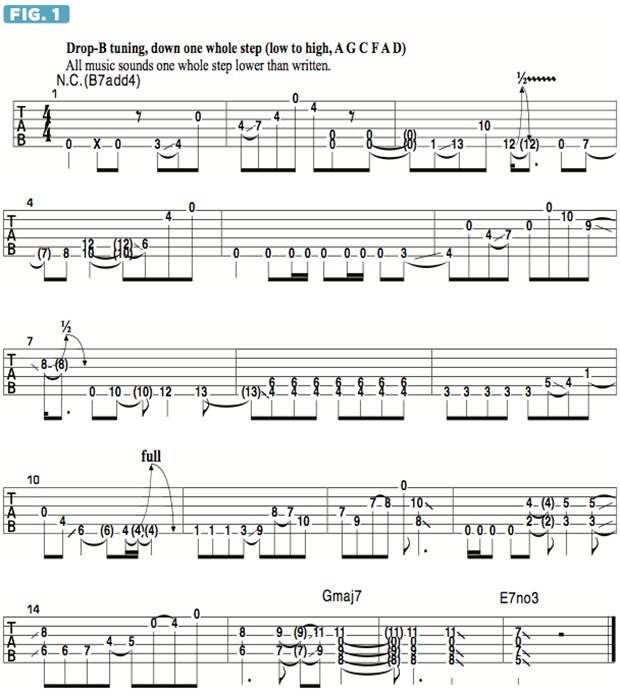How to Craft a Long Riff with No Repetition
How to give the impression of repetition in a riff, without there actually being any repetition at all.
One songwriting approach we occasionally take in Periphery is to come up with long phrases—say, 16 bars long—in which nothing repeats.
We refer to these as “run-on-sentence” riffs. The idea is to give the impression of repetition—I would say 98 percent of all metal riffs are built from repetitive figures—but without there actually being any repetition at all. Writing this way is challenging, but it is also a fun approach that offers a lot of room for creativity.
A great example of a passage that demonstrates this concept is the second verse of our song “Graveless” (Juggernaut: Omega).
Normally, we tune to drop-D down a whole step (low to high: C G C F A D), but for this song we use what I call “drop-A” tuning, for which the sixth string is tuned down an additional step and a half, to A, resulting in a tuning of, low to high, A G C F A D. FIGURE 1 illustrates the above mentioned riff, which ends in bar 17 on an E7no3 chord.
One of the hallmarks of our music is that it sounds very angular and jagged, which keeps things interesting for us as musicians. We like those qualities in other bands’ and players’ music, as that jarring quality is something that appeals to us. In addition to the fact that none of the riffs in FIGURE 1 repeat, many of the phrasing ideas go “over the bar line,” meaning they resolve rhythmically in unusual and unexpected places.
Another element here is a technique I described in previous columns, wherein sections of the riff are based on chord patterns that are broken down into individual notes. Across bars 1 and 2, I outline an A7add4 chord by sounding both the major third, C#, and the fourth, D, simultaneously.
wo hits on the bottom open two strings are followed by a slide up the sixth string to Bb at the 13th fret, after which I play Bb an octave higher followed by A on the sixth string’s 12th fret. That’s followed by a technique that I use in many of my riffs, wherein I slide back down from high on the neck to where the riff started, as I do in bar 4, after which I continue on a similar but twisted path, with different notes and harmonic relationships referenced.
One of the things I like about this tuning is that you can get octaves by simply playing what would ordinarily be a root-fifth power-chord shape on the bottom two strings in standard tuning: in bar 8, I sound a C# octave by fretting the fourth fret on the sixth string in conjunction with the sixth fret on the fifth string. Octaves come back into play in bar 13, fretted this time in a conventional manner on the fifth and third strings.
The phrase wraps up with a pair of four-note chords, both of which include the open fourth string: for Gmaj7, a high third, B, is sounded on the third string, and for E7no3, the dominant seventh, D is fretted on the third string.

Get The Pick Newsletter
All the latest guitar news, interviews, lessons, reviews, deals and more, direct to your inbox!










